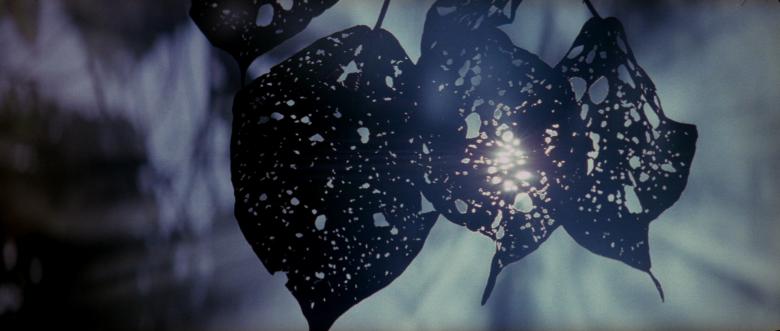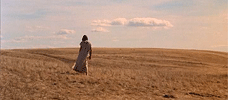Reviews
Terrence Malick
USA, 1998
Credits
Review by Michael Nordine
Posted on 14 October 2012
Source 35mm print
Categories Another World: Terrence Malick at LACMA
The Thin Red Line is both a continuation of, and more fully realized meditation on, the same themes that have preoccupied Terrence Malick since at least his first film. In his hands, Guadalcanal Island is not only the site of a tide-turning World War II battle but, more importantly, the ultimate proving grounds for his characters. The tides with which he’s most concerned aren’t those of war but rather those of the Pacific, whose rhythmic waves have a musical cadence, and those within the many soldiers of Charlie Company. As many know, Malick “disappeared” (it seems odd to say this of a man who was never publicly there in the first place) for twenty years after Days of Heaven. What to make of this absence is anyone’s guess, and some have posited that Malick may have done his best work during those lost years had he simply chosen to. This has never been the case for me. The Thin Red Line was my introduction to Malick, and to this day no other film transfixes me in quite the same way.
Malick intends neither to deliver an anti-war message nor shore up American patriotism. He takes no moral stance on the many conflicts - natural, global, internal - that the film comprises, and certainly not on the extended battle sequence that is The Thin Red Line’s narrative centerpiece. He simply presents it as an occurrence best understood phenomenologically. War, as Malick sees it, has existed since the rosy-fingered dawn of nature, long before men took up sticks and stones of their own, and is treated as a near-perpetual condition of existence rather than something worth lamenting or cheering on. The Battle of Guadalcanal is one of slow starts and foggy results; even the film’s highest ranking officer admits that the strategically located island’s place in the bigger picture (“if there is such a thing”) is beyond him. Historians still debate whether Guadalcanal ultimately made a sizable difference in World War II, but this doesn’t concern Malick either. His film features no contextual intertitles, and certainly no cuts to the present day in order to show how the battle shaped the subsequent lives of its combatants. Malick isn’t nearly as concerned with wartime strategy as he is with the collective that forms out of the many individuals in C Company. This idea is hinted at quite cogently in, of all places, the tagline on the film’s poster: “Every man fights his own war.” War is a stepping stone to greater things for some of Malick’s characters, while others can only think of returning to those waiting for them at home. Out of The Thin Red Line’s many characters’ opposing philosophies emerges what might be called a fractured whole, a sense of unity that transcends its diverse facets.
The real war in The Thin Red Line is inside, in the granular details that make us who we are. Malick makes this clear in the first few frames of his film when the camera settles its gaze on the eyes of an alligator - who doesn’t return the glance - slinking into the murky water of a swamp. Nature’s savagery (and, perhaps more to the point, indifference) embodied, the creature submerges itself out of sight but not out of mind—what it stands for never leaves the film. The overture to Hans Zimmer’s ethereal score is at its most foreboding and bass-laden here. The moment is perhaps one of the film’s most ominous, but also one of its most evocative: Malick can’t help but be gentle even at his most sinister.
The voiceovers in The Thin Red Line, unlike those of Badlands and Days of Heaven - which, though certainly lyrical, tend to relate at least somewhat to their accompanying imagery - are almost entirely abstract and disconnected from what’s actually occurring onscreen at any given moment. They’re also in present tense. Malick has had an affinity for montage since his debut film, and his pieced-together aesthetic is nowhere more present than in the fanciful imagery accompanying such inner monologues as the following:
Who are you who live in all these many forms? You’re death that captures all. You, too, are the source of all that’s gonna be born. You’re glory. Mercy. Peace. Truth. You give calm a spirit. Understanding. Courage. The contented heart.
As we hear these lines, sunlight passes through leaves, and trees are seen from ground-level, as though the camera were looking straight up for shapes in the clouds and happened upon this foliage instead. This particular soliloquy is delivered approximately one hour into the film, but the exact placement of the moment at which it occurs is essentially moot. The significance of these voiceovers lies mostly in their gradual accumulation and the fact that so many disparate voices express such similar thoughts and feelings - they’re not unlike a Greek chorus. The elliptical nature of these sequences frustrates some viewers, but no other element in Malick’s films appeals to me more. Where others see pretension I find a humble attempt to connect the smallest moments to the greatest truths, as though his own modesty increases at the same rate as his loftiness.
The nature imagery in these voiceovers is in many ways a return to The Thin Red Line’s prologue, which features the AWOL character of Witt among the natives of a Melanesian island. They sing, dance, and remain untouched by the outside world. As signified by the above-mentioned alligator as well as shots of snakes and feral dogs, nature in The Thin Red Line is far more hostile than in Malick’s previous films. “Look at this jungle,” one character muses. “Look at those vines, they way they twine around, swallowing everything. Nature’s cruel.” The exception is the paradisaical milieu in which we first meet Witt. In leaving the island on which he recalls his mother’s last moments and the “calm” with which he hopes to meet his own, Witt - nature-lover and philosopher that he is1 - knows he’s headed toward something darker. Malick draws a clear line between this brief section of the film and everything to follow when, in the first off-island shot we see, the brig carrying C Company to Guadalcanal is shown coughing plumes of black smoke into the sky. Moments later, Witt replies to the apparently cynical Sgt. Welsh’s assessment that “there ain’t no world but this one” with the wide-eyed declaration that he’s seen another. Having seen this other world is both a blessing and a curse for Witt. Going AWOL introduced him to true splendor, but his heightened awareness of the transcendent has distanced him from the “one world” in which he lives.
Further removing The Thin Red Line from Malick’s first two films is the fact that it has nearly a dozen narrators rather than just one. There’s Witt, whose fixation on death springs not from morbidity but curiosity, and who is the closest thing the film has to a protagonist; Welsh, who puts on the air of a hardened cynic but may well be the bravest, most selfless soldier in C company; Bell, who speaks and dreams only of his wife at home; the list goes on. The twenty-year hiatus Malick took after Days of Heaven cloaked the auteur in mystery, and many a movie star clamored to attach himself to Malick’s new project in any capacity long before The Thin Red Line even went into production. The final cast includes Sean Penn, Nick Nolte, Jim Caviezel, John Travolta, Woody Harrelson, John Cusack, George Clooney, John C. Reilly, and Adrien Brody; Viggo Mortensen, Bill Pullman, Mickey Rourke, and Martin Sheen all had their scenes excised entirely, and Billy Bob Thornton is said to have recorded six hours of narration that went similarly unused. The reason this bears mention is because several of the actors just named are in The Thin Red Line for what amount to little more than cameos, something that’s distracted many viewers but is actually in keeping with one of Malick’s central conceits: granting equal footing to the cosmic and infinitesimal. War equalizes all soldiers just as Malick equalizes all actors2: “It makes no difference who you are, how much training you got or how tough a guy you might be,” John C. Reilly’s character tells us. “You’re in the wrong spot at the wrong time, you’re gonna get it.” Likewise, no battle is so important that Malick won’t cut to a brief shot of fruit bats hanging upside down or tall grass swaying in the wind before returning to the gunfire and explosions. Malick constantly places the big next to the small, whether it be lieutenant and private, human and animal, or animal and plant. This is, of course, in direct opposition to the hierarchical structure of the military, and any tension that results from the juxtaposition is left unresolved.
What The Thin Red Line concerns itself with, and what it may ultimately be said to be, is a series of disparate elements cobbled into a semi-unified whole. This comes through most clearly in the character of Witt. Consider this line spoken by him: “Maybe all men got one big soul everybody’s a part of, all faces are the same man. One big self” and the relation it bears to this excerpt from the film’s final monologue, which is delivered by the seemingly minor character of Train: “Are they the workings of one mind? The features of the same face?” That such similar lines are spoken by two characters who never once interact onscreen strengthens this through-line. The Thin Red Line is in no way seamless, nor is it meant to be. If it were, it wouldn’t accurately depict the world as Malick sees it. The idea of a fractured whole is found in stories, in war, and in life. In much the same way, The Thin Red Line may go from A to Z, but not necessarily in order. “We were a family,” muses Witt. “How’d it break up and come apart so that now we’re turned against each other?” Of the many men who compose this broken family, none stands out to me more than Bell. He is the only character aside from Witt to have what may be called flashbacks to his pre-war life (and his outnumber Witt’s), and his thoughts all center around his wife:
Love. Where does it come from? Who lit this flame in us? No war can put it out, conquer it. I was a prisoner. You set me free.
This is The Thin Red Line at its most tender, and a needed emotional counterbalance to its more cerebral ruminations. Bell isn’t interested in philosophy, nor does he consider the Japanese his enemy in any real sense of the word. The most intense battle in which he’s involved brings him to tears, and he is in many ways the heart of the film. There’s not a moment away from his wife that isn’t also a return to her. (“There’s nowhere we can hide except in each other,” he says.) Late in the film, he receives a Dear John letter, and only this - not his own injuries or the death of his friends, but this - silences these romantic voiceovers. We don’t hear from him again.
The majority of the soldiers in C Company are neither heroes nor cowards. They’re simply men, many of whose spirits are too fragile for the war in which they’re involved. They look upon each other and the world with searching eyes as though looking for something in the world that matches their own conception of it. Of the countless moments they witness, few are as powerful as the last: a major character has perished, and the self-proclaimed cynic who had an uneasy friendship with him reveals himself as the softhearted figure he truly is. And then, as the men’s faces blend together more than at any other moment in the film, the heretofore minor character mentioned above recites The Thin Red Line’s final monologue:
Where is it that we were together? Who were you that I lived with, walked with? The brother. The friend. Darkness, light. Strife and love. Are they the workings of one mind? The features of the same face? Oh, my soul. Let me be in you now. Look out through my eyes. Look out at the things you made. All things shining.
We then see three Melanesian children row their way slowly down a river; a pair of gorgeous, multi-colored birds; and, finally, what looks to be the beginnings of a coconut tree growing on a beach as waves crash quietly behind it. This progression - from human to animal to plant - is likely inspired by the Pythagorean precept of fourfold transmigration, but Malick makes it all his own. In the midst of life we may be in death, but the opposite is true as well.
More Another World: Terrence Malick at LACMA
We don’t do comments anymore, but you may contact us here or find us on Twitter or Facebook.








